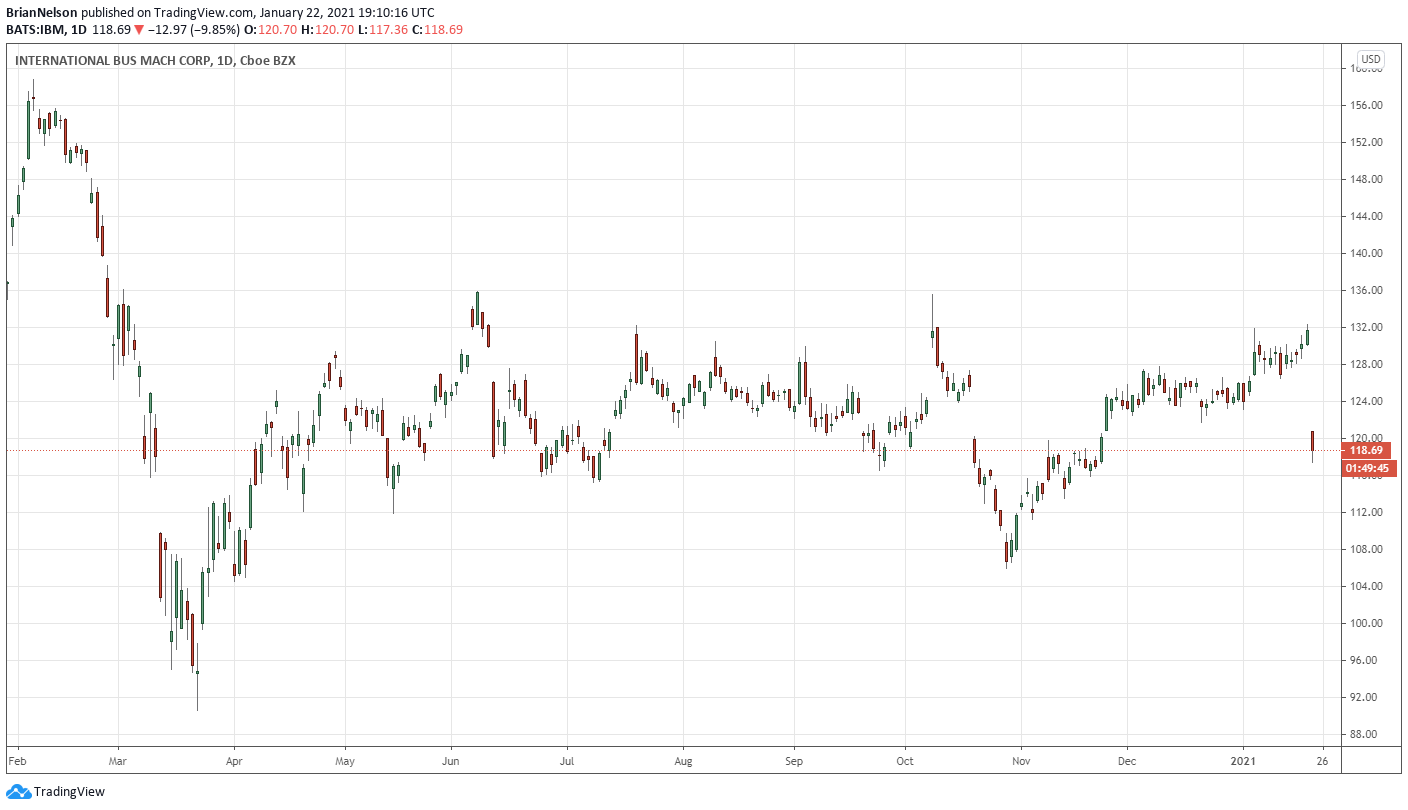IBM Is Still A Disappointment

We’ve never liked IBM. The company has all the attributes of a stock that we'd prefer to stay as far away from as possible.
By Brian Nelson, CFA
We received a few questions regarding IBM (IBM) from members, and we wanted to make this brief post. Prior to the company’s fourth-quarter 2020 results, released January 22, shares had a price-to-fair value (P/FV) ratio of 0.96 (1=fairly valued), and they were not included in either the Best Ideas Newsletter portfolio, or the Dividend Growth Newsletter portfolio, or the High Yield Dividend Newsletter portfolio. This means that we have very little interest in the company, and our interest continues to be minimal. You can read our take on the firm’s track record in Value Trap (published 2018):
As recently as mid-2014, IBM believed it could attain $20 per share in adjusted operating earnings by 2015, a view that was supported in part by an aggressive share buyback program. Warren Buffett’s Berkshire Hathaway may have based the ownership of shares at the time, in part that IBM had been a moaty company, but also that he’d own more of the company over time thanks to the buybacks. During the first quarter of 2014 alone, IBM spent a staggering $8.2 billion on share repurchases, but fundamentals were deteriorating. The same quarter revealed a 1% adjusted decline in revenue and a 22% decline in operating (non-GAAP) income, while revenue in its “growth” markets fell 11%. Management had been using buybacks to disguise underlying operating deterioration, and what’s worse, the company was executing the repurchases at value-destroying prices to do so.
Subsequent quarters at IBM were even worse, sometimes including large charges and lower-than-expected tax rates, two conditions that when combined with revenue weakness implied that earnings quality was deteriorating at a fast rate. It didn’t take long before management came around to realizing that buybacks weren’t going to save the day. In October 2014, after yet another abysmal fundamental quarter, the company pulled its operating earnings-per-share target of $20 by 2015. Poor earnings quality and arguably too much of a focus on earnings-per-share growth via buybacks likely led management to take its eye of the ball where it matters, economic value creation. Just a few years later, Warren Buffett would sell all his IBM shares.
Focusing too much on earnings per share can get even the most sophisticated investors in trouble. The enterprise valuation framework helps market participants determine whether share buybacks are value-creating (they add to the intrinsic value estimate of a company) or if they are value-destructive (they detract from the intrinsic value estimate of a company). It may seem that talking about the balance sheet with respect to buybacks, which seemingly only serve to enhance the earnings per share on the income statement, is a bit off topic, but the balance sheet is a source of company value, too, and the balance sheet is where share buybacks are financed, either from cash generated from internally-generated free cash flows or from newly-issued debt.
IBM’s fourth-quarter 2020 performance offered little in the way of changing our mind. Revenue dropped 6% during the period, and while the company is making progress with total cloud revenue and reducing debt, there are so many other companies out there that offer much better risk-reward opportunities, especially considering the size of IBM’s net debt position, which stood at $47.2 billion at the end of the year (including Global Financing debt). Our favorite ideas are included in the Best Ideas Newsletter portfolio, Dividend Growth Newsletter portfolio, and High Yield Dividend Newsletter portfolio (order newsletter).
Concluding Thoughts
You have to read Value Trap.
With the exception of IBM’s free cash flow generation health (the adjusted measure is targeted in the range of $11-$12 billion in 2021), IBM is a quintessential example of the type of companies Valuentum investors strive to stay as far away from as possible. IBM’s share-price momentum has been under pressure, its shares aren’t trading below the low end of the fair value range, and the company holds a huge net debt position that limits financial flexibility while weighing heavily on its poor Dividend Cushion ratio of 0.6.
We’re not fans. In fact, we’ve never been fans of IBM.
IBM's 16-page Stock Report (pdf) >>
IBM's Dividend Report (pdf) >>
-----
Related: NOW, VMW, OTEX, FTNT, NET, WORK, CRM, ORCL, HPE, GIB, SSNC, DELL, HPQ, RHT, NTAP
Valuentum members have access to our 16-page stock reports, Valuentum Buying Index ratings, Dividend Cushion ratios, fair value estimates and ranges, dividend reports and more. Not a member? Subscribe today. The first 14 days are free.
Brian Nelson owns the SPY, SCHG, DIA, QQQ, VOT, and IWM. Some of the other companies written about in this article may be included in Valuentum's simulated newsletter portfolios. Contact Valuentum for more information about its editorial policies.
1 Comments Posted Leave a comment